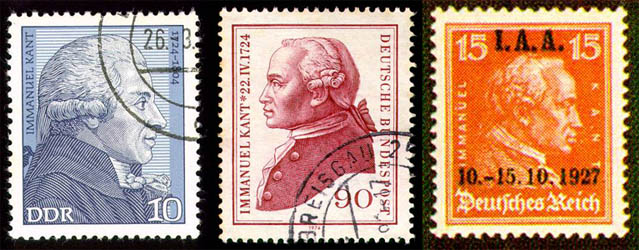
Andrew Carnegie
Alfred
Aristotle
Charlemagne
Dante
Franklin
Hegel
Kant
Laplace
Lincoln
McKinley
Milton
Newton
Plato
Socrates
Virgil
Washington
Carnegie Building
|


- About the image: Various German postage stamps featuring Kant, the orange/red one on the right from 1927 and the red one in the center from 1974.
- Appearance: Kant stood less than five feet tall, and his head was disproportionately large for his body. His frame suffered from a slight corkscrew twist, which made his left shoulder droop, his right shoulder curve back, and his head tend to lean to one side.
- Marriage: Kant twice considered marriage, but on both occasions he took so long in making up his mind that by the time he decided (to say yes on both occasions), one of the women had married someone else and the other had moved to another city.
- Geography Teacher: Kant was established as the first teacher of physical geography, despite the fact that throughout his life he never set eyes on a mountain and may never have seen the open sea (which was 20 miles away).
- Psychology: Throughout his life, Kant was a severe hypochondriac. By the time he was approaching seventy, he had perfected this condition to the point where he was a master of this art. Each month he would send to the Köningsberg chief of police for the latest mortality statistics, and from these he would calculate his own life expectancy. He became convinced that constipation clouded his brain, and he added an impressive array of laxatives to his room-sized medicine cabinet. He would read through medical journals describing the latest discoveries to see if he could diagnose himself with any of the new diseases.
It is said that hypochondria is often a defense mechanism against paranoia. Despite exhaustive practice at his hobby, hypochondria, Kant's paranoia gradually began to get the upper hand. He started to experience pressure on his brain, which he decided was caused by a rare form of electricity in the air. Such obsession with "electrical powers" is often associated with schizophrenia.
- A Satirical Look at the Metaphysical: Kant wrote a satirical book entitled Dreams of a Ghost-Seer Elucidated by Means of Metaphysical Dreams. This "ghost-seer" he writes of is a Swedish mystic and visionary named Swedenborg, who is famous for his descriptions of travels through heaven and hell. In 1756 Swedenborg had published his eight-volume work Arcana coelestia (The Secrets of Heaven). After 10 years only four copies of his work had been sold, one of these known to belong to Kant. These volumes of metaphysical rantings had a deep effect on Kant - enough to inspire an entire book satirizing them! Kant pokes fun at Swedenborg in his introduction, saying "The author confesses with a certain humility that he was so simple-minded as to track down the truth of some tales of the sort mentioned. He found - as usual, where one has nothing to look for - he found nothing." Kant also mocks him as "the worst visionary of them all" and of "sundry airy thought-worlds...hewn...out of fraudulent concepts." Beneath his constant mocking and intellectual contempt hid an unmistakable interest in Swedenborg. Kant longed to believe in metaphysics (even if not in this form), but his years of logical intellectual thinking made it almost impossible for him to accept these answers for unknowable questions.
Strathern, Paul. Kant in 90 Minutes.
Chicago: Ivan R. Dee, 1996, pg.15, 19-21, 24-25, 43, 48-49
call number: B2798.S87 1996
Hong Kong Baptist University.
"Immanuel Kant Image Gallery," available from
http://www.hkbu.edu.hk/%7Eppp/Kant_gallery.html;
Internet; accessed 2 March 2005.
back

|

